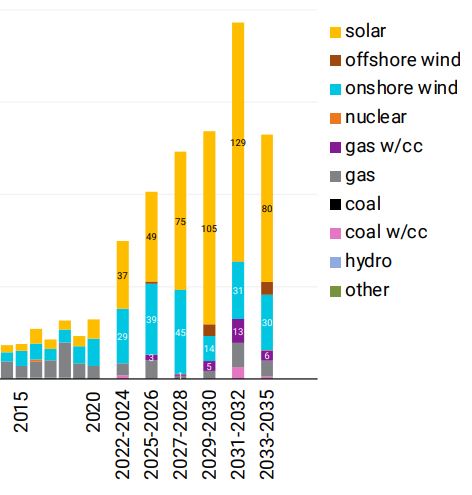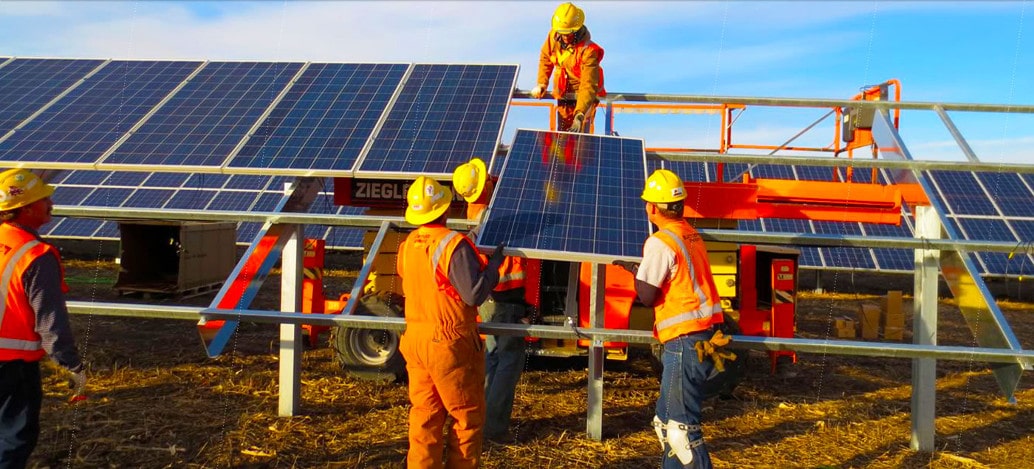The Inflation Reduction Act of 2022, a bill which has full Democratic support in the Senate, contains $370 billion in spending for renewable energy and climate measures and calls for a 40% reduction in carbon emissions by 2030.
Princeton University released a Rapid Energy Policy Evaluation and Analysis Toolkit (REPEAT) in collaboration with Dartmouth College, Evolved Energy Research, and Carbon Impact Consulting, outlining the potential impact of the bill should it become law.
The impact on the US solar industry would be huge, to say the least. Princeton said solar deployment may accelerate from 2020 rates of 10 GW of capacity added per year to nearly five times as much by 2024, adding 49 GW of utility-scale solar each year. Solar deployment may be well over 100 GW per year by 2030, said Princeton.

Image: Princeton
Investment in solar could reach $321 billion in 2030, nearly double the figure of $177 billion expected under current policy. The Act would lead to nearly $3.5 trillion in cumulative capital investment in new American energy supply through the next decade, said the report.
Annual US energy expenditures are expected to fall by at least 4% in 2030 under the act, a savings of nearly $50 billion dollars per year for households, businesses and industry. This translates into hundreds of dollars in annual energy cost savings for US households. Tax credits, rebates, and federal investments in the Act would shift costs from energy bills to the progressive federal tax base.
The Act has numerous provisions to boost solar, from a long-term extension of the solar investment tax credit at 30%, to $30 billion in production tax credits for renewable energy and storage manufacturing, a 100% manufacturing tax credit, and other funds to support environmental justice and agriculture.
The REPEAT report said the Inflation Reduction Act could cut annual emissions in 2030 by an additional 1 billion metric tons below current policy, including the impacts from the Bipartisan Infrastructure Law. This would represent closing two-thirds of the remaining emissions gap between current policy and the nation’s 2030 target of lowering emissions 50% below 2005 levels.
“It really makes me incredibly optimistic,” said Princeton’s Jesse Jenkins, leader of the REPEAT Project. “It doesn’t get us all the way there on its own, but it keeps us in the climate fight.”
This content is protected by copyright and may not be reused. If you want to cooperate with us and would like to reuse some of our content, please contact: editors@pv-magazine.com.









It sounds like a good idea to increase solar PV capacity, but has anyone figured out where to put this new land-intensive solar PV so that trees do not have to be cut or farmland/open land does not have to be paved over with solar panels?
Yes, many of us have thought about it. If the ground is already covered with asphalt, cover the asphalt with 15 feet above the ground covers made with solar panels. if you have a Canal or water storage faculty, cover it with solar shading. Every asphalt roof, steel roof or tar and gravel flat roof gets solar. Parking lots, schools, government buildings, train stations and railroad right of ways get above ground solar. The closer to the populated areas the better for distribution. We should not cut down a single tree to make room for solar and most existing buildings will accommodate solar. Thomas Edison wanted us to have a DC power plant on every other block with local production and distribution and solar with battery storage can give us that. On my home and in my yard, I have enough room to install enough solar, on a 6,000 square foot lot, to power 4 homes and still have a dozen trees. On the roof, over the driveway, over the patio cover and a couple of storage sheds. If every home and business had solar panels with storage, we could be carbon neutral. It is the utilities, that sell us their energy, that don’t like the business model of owner owned solar panel systems, because it cut them out of their profits. They like converting Direct Current Electricity to Alternating Current Electricity so they can transmit it long distances from power plants they own and control. That is why the propose covering “virgin land”, tens or even hundreds of miles away from where the electricity will be ultimately used, rather than bring the solar closer on rooftops of existing buildings. Our roofs could generate the electricity and the utility could store it to sell it back to us for a profit as they are now doing at the old “Moss Landing power plant” in California. Everything we use ourselves; we keep for free, and everything we send to the grid, for storage, we get a 50% credit when we buy it back.
Roofs and parking lots are a good place to start. Warehouses and big box stores have large flat roofs ideal for solar. Solar canopies of parking lots offer the added benefit of partial weather protection for parked cars.
This is wonderful news, but underneath it all lies the problem of capital investment made on behalf of the utilities intending to recapture the cost through the sale of energy over the course of time. To date, the utility industry has done a good job of navigating this. The IRA will make the naturally adversarial relation between residential solar/industry much more confrontational much more sooner. With the political influence industry has, residential solar will certainly pay
Solar panels and sheep grazing can work together to actually increase wool yield etc: https://www.abc.net.au/news/rural/2022-05-30/solar-farm-grazing-sheep-agriculture-renewable-energy-review/101097364
Plus – you can grow other things under solar panels: https://en.wikipedia.org/wiki/Agrivoltaics
Another advantage of having sheep and cattle graze near/under solar panels is that the panels provide much–needed shade for the animals on hot days (which will keep getting hotter and hotter with global warming).
There are many people and environmental groups that want to get rid of GHG methane belching ruminant sheep and cattle
South Texas as well as West Texas have plenty of sunshine.
Also, don’t forget that there are literally tens of millions of rooftops (residential and commercial) in the U.S. can that host a huge amount of solar. As the panels inevitably get lighter, thinner, more efficient and cheaper (after current temporary price bump through materials and shipping) – that will mean potentially dozens of Gw’s.
Best place for solar is on your roof, on industrial roofs and over car parks. Studies have shown that there’s also actually benefit for mixing solar with agriculture, where a lot of low height shade resistant crops like lettuce and some other vegetables grow equally well or better without full sun, so partially shaded fields (with low density solar) can actually boost productivity.
Having large areas of productive land fully covered by panels is the worst option and hopefully no one is doing that. As long as any of the other available spaces for solar exists, (like every shopping center car park covered) it shouldn’t be allowed.
If all the available suitable roof space was used with low efficiency 15% panels, it would provide about 40% of the electricity we need, not counting other spaces like car parks etc.
Have you heard of “Land Banking”. Farmers are paid to leave their fields fallowed (no crops) for a period to let the land just grow weeds and other nitrogen rich plants to refurbish the soil. I have seen articles of direct on the ground solar panels that actually sit on 12-inch feet and are lined up end to end then plugged into a temp-power400 amp service pole supplied by the utility. Movable from farm to farm, like they do for bees by beekeepers, they could not only allow the land to re-generate but generate a living for the farmer if they chose to land bank. Nothing says solar has to be on a permanent mount. I used queen size angle iron bed frames to mount 4 -100 watt off grid solar panels on and just move them and plug them in with MC4 connectors in different places in my yard so it could be possible to do the same thing on a larger scale.
@K Arthur,
You wrote “has anyone figured out where to put this new land-intensive solar PV so that trees do not have to be cut or farmland/open land does not have to be paved over with solar panels?”
Please see https://pv-magazine-usa.com/2022/03/10/solarfood-in-ethanol-fields-could-fully-power-the-united-states/ for a thorough look at the issue.
The short answer to your question is that installing PV on the land currently used to grow corn for ethanol (not including acres devoted to corn for food) is more than enough to power the entire United States energy requirements. This makes enormous sense since the production of corn ethanol is a net source of greenhouse gases.
An entirely separate solution would be to install PV over parking lots. That alone would provide enough electricity for everyone to drive an electric car.
Many of the commenters have provided great ideas for the less impactful solar PV siting. But how many of these ideas are actually being used today? The solar installers say for non-residential sites, the least costs are to clear-cut, grade, build, and fence off the site. Building on roofs, parking lots, etc is more expensive. It doesn’t take long to understand that solar installers aren’t doing this to save the planet, they do this to make a buck. Unless prohibited or disincentivized they will go the least cost/highest profit route.
We need to look carefully at how this increase in solar PV will be implemented
Just to add another way – in the not too far off future, having new commercial buildings using solar glass, (currently very transparent and 10% efficient) mandating that new buildings are more energy efficient, have solar panels on roofs, and the almost certain ultracheap solar that will be far lighter and be able to cover more of a roof without weight concerns.
And, solar panel son land don’t have to take up so much space – solar “fences”, like the one in this article, have proved just as, if not more efficient:
https://e360.yale.edu/features/small-solar-agriculture-technology
https://cleantechnica.com/2022/07/25/new-research-says-vertical-solar-panels-have-improved-performance/
https://www.pv-magazine.com/2021/05/21/next2sun-unveils-bifacial-photovoltaic-fence/
Plants also cool panels, increasing their output:
https://www.pv-magazine.com/2021/08/24/green-roof-improves-solar-panel-efficiency-by-3-6-on-average/